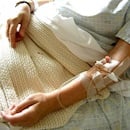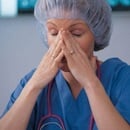
How to Create a No-Blame Work Environment
Nurses are patient advocates. As such, we need to create a culture of safety in which cooperative teamwork, staff empowerment, and the development of a "no-blame" work environment provide a framework for safe practice.
Eleven years ago, the Institute of Medicine (IOM) released a report entitled: To Err is Human: Building A Safer Health System. This report fundamentally changed the way in which the healthcare profession assigns blame when medical errors occur. Essentially, this report concluded that medical errors are mostly caused by faulty systems rather than individuals. This shifts the blame from the individual to the environment and has led to many improvements in methods and technologies over the years, such as computerized physician order entry systems, bar coding for patient and medication identification, and electronic health records.
Nevertheless, safer procedures and new technology are only effective when accompanied by safe human interactions. Strong leadership and support, direct and open communication, strong teamwork, and staff empowerment are vital components in the creation of a culture of safety (Institute of Healthcare Improvement [IHI], 2010).
According to the IHI, a culture of safety is created when healthcare professionals are not merely encouraged to work toward change; they take action when it is needed. In addition, an organization can improve safety only when leaders are visibly committed to change and when they enable staff to openly share safety information. When an organization does not have such a culture, staff members are often unwilling to report adverse events and unsafe conditions because they fear reprisal or believe reporting won’t result in any positive change.
The IHI offers several suggestions for creating a culture of safety, including the recommendation to designate a Patient Safety Officer, create a reporting system for medical errors, and relay safety reports at every shift change. Other recommendations include involving patients in safety initiatives simulating possible adverse events in a safe learning environment and providing patient safety feedback to front-line staff.
In January 2010, the American Association of Critical Care Nurses (AACN, 2010) released Standards for Establishing and Sustaining Healthy Work Environments. These standards form an integral part of creating a culture of safety by defining the essential elements of a healthy work environment that must be created before healthcare professionals can practice safely.
The six essential standards for establishing and maintaining healthy work environments are:
- Skilled Communication: Nurses must be as proficient in communication skills as they are in clinical skills.
- True Collaboration: Nurses must be relentless in pursuing and fostering true collaboration.
- Effective Decision Making: Nurses must be valued and committed partners in making policy, directing and evaluating clinical care, and leading organizational operations.
- Appropriate Staffing: Staffing must ensure the effective match between patient needs and nurse competencies.
- Meaningful Recognition: Nurses must be recognized and must recognize others for the value each brings to the work of the organization.
- Authentic Leadership: Nurse leaders must fully embrace the imperative of a healthy work environment, authentically live it and engage others in its achievement.
These standards ensure that nurses have the skills, resources, and accountability to make decisions that result in excellent professional nursing practice and contribute to the development of a safe culture.
In addition, you can contribute to the creation of a safe culture by staying up-to-date on patient safety issues and your facility’s safety policies. The Joint Commission (TJC), National Patient Safety Foundation (NPSF), and the Agency for Healthcare Research and Quality (AHRQ) all offer patient safety tools and recommendations on their websites. RN.com also offers several patient safety courses, including courses on medication errors, high-alert medications and 2010 Workplace Safety and Patient Care Standards.




